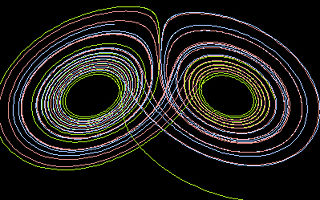Complexity science

Complexity science in health care
Complexity science and chaos theory are proposed as further explaining the nature of medical knowledge[1][2] and education[3].
In health services research, although complexity theory has not advanced to the state of being able to mathematically model healthcare delivery, it has been used as a framework for case study[4][5][6][7][8] and traditional bivariate analysis[9][10] of healthcare delivery. For example, a systematic review of organizational interventions to improve the quality of care of diabetes mellitus type 2[9] and heart failure[10] suggests that interventions based on complexity theory will be more successful.
Complexity science has been proposed as a model for organization change in medicine.[11][11] However, if the goal of modeling healthcare is to comply with specific quality indicators, interventions based on systems theory may be more effective than those based on complexity theory.[12]
In basic science research, fractal patterns have been found in cardiac conduction and fluctuations in vital signs over time.[13] Fractals are evidence of a system that follows the non-linear mathematics of a complex adaptive system. That are many other examples of fractal patterns in nature including the prediction of weather patterns.[14]
References
- ↑ Sweeney, Kieran (2006). Complexity in Primary Care: Understanding Its Value. Abingdon: Radcliffe Medical Press. ISBN 1-85775-724-6. Book review
- ↑ Holt, Tim A (2004). Complexity for Clinicians. Abingdon: Radcliffe Medical Press. ISBN 1-85775-855-2. Book review, ACP Journal Club Review
- ↑ Fraser SW, Greenhalgh T (2001). "Coping with complexity: educating for capability". BMJ 323 (7316): 799–803. PMID 11588088. [e]
- ↑ Anderson RA et al. (2005). "Case study research: the view from complexity science". Qualitative Health Res 15: 669–85. DOI:10.1177/1049732305275208. PMID 15802542. Research Blogging.
- ↑ Miller WL et al. (2001). "Practice jazz: understanding variation in family practices using complexity science". J Fam Pract 50: 872–8. PMID 11674890. [e]
- ↑ Crabtree BF et al. (2001). "Understanding practice from the ground up". J Fam Pract 50: 881–7. PMID 11674891. [e]
- ↑ Sturmberg JP (2007). "Systems and complexity thinking in general practice: part 1 - clinical application". Australian Family Physician 36: 170–3. PMID 17339983. [e]
- ↑ Safford MM, Allison JJ, Kiefe CI (2007). "Patient complexity: more than comorbidity. the vector model of complexity". J Gen Intern Med 22 Suppl 3: 382–90. DOI:10.1007/s11606-007-0307-0. PMID 18026806. Research Blogging.
- ↑ 9.0 9.1 Leykum LK et al. (2007). "Organizational interventions employing principles of complexity science have improved outcomes for patients with Type II diabetes". Implementation Science : IS 2: 28. DOI:10.1186/1748-5908-2-28. PMID 17725834. Research Blogging.
- ↑ 10.0 10.1 Leykum LK, Parchman M, Pugh J, Lawrence V, Noël PH, McDaniel RR (2010). "The importance of organizational characteristics for improving outcomes in patients with chronic disease: a systematic review of congestive heart failure.". Implement Sci 5: 66. DOI:10.1186/1748-5908-5-66. PMID 20735859. PMC PMC2936445. Research Blogging.
- ↑ 11.0 11.1 Litaker D, Tomolo A, Liberatore V, Stange KC, Aron D (February 2006). "Using complexity theory to build interventions that improve health care delivery in primary care". J Gen Intern Med 21 Suppl 2: S30–4. DOI:10.1111/j.1525-1497.2006.00360.x. PMID 16637958. PMC 2557133. Research Blogging.
- ↑ Rhydderch M et al. (2004). "Organisational change theory and the use of indicators in general practice". Quality & Safety in Health Care 13: 213–7. DOI:10.1136/qhc.13.3.213. PMID 15175493. Research Blogging.
- ↑ Goldberger AL (1996). "Non-linear dynamics for clinicians: chaos theory, fractals, and complexity at the bedside". Lancet 347: 1312–4. PMID 8622511. [e] Full text at Ebsco
- ↑ Lorenz's Model of Convection. Retrieved on 2007-11-21.